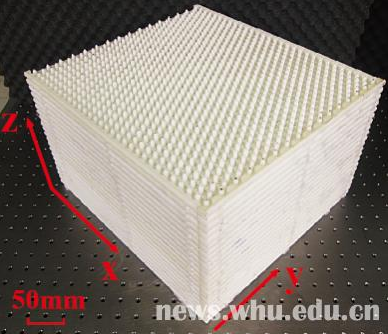Physicists from the University of Texas at Dallas (UT Dallas) and China’s Wuhan University have 3D printed polymer rectangular rods to create a Weyl sonic crystal cube capable of reflecting sound.
A Weyl sonic crystal is considered a quantum material and acts as an acoustic analogue. Similar to graphene, electrons found on the surface of Weyl particles exhibit an electric charge which enables it to function for electronic devices. This is due to its unique properties which allow zero reflection and negative refraction, permitting acoustic and light waves.
Forbidden in nature
“We have demonstrated that it is possible to construct a sonic crystal to manipulate sound in a way that is forbidden in nature,” said. Dr. Fan Zhang, assistant professor of physics at UT Dallas and one of the authors of the study published in Nature.
“The results could inspire new directions in wave manipulation, such as acoustic cloaking technologies, and advances in photonics and electronics.”
Controlling sound and light waves with additive manufacturing
Reflection and refraction of waves appear at the interface between two different media. According to the research, “these two fundamental interfacial wave phenomena form the basis of fabricating various wave components, such as optical lenses.”
Such lenses are used within cameras and microscopes as well as acoustic devices as refraction can direct and refocus light and sound into clear images and vibrations.
The study adds, “In general, reflection is inevitable during the refraction process, but this is often undesirable in designing wave functional devices.” Thus the researchers were inspired to use sound-controlling crystals to engineer artificial substances with negative refraction.
Negative refraction, also known as mirror image reflection, occurs when sound or light waves change their direction, being bent, as they travel from one medium to another. Dr. Zhang explained, “Because of the negative refraction and zero reflection of sound at the interface of two facets, this type of crystal could act kind of like a cloaking device for sound.”

The Weyl sonic crystal cube
Experimenting with negative refraction, the researchers 3D printed a Weyl sonic crystal cube the size of a desktop computer. The cube was made from 3D printed polymer rectangular rods which were stacked in layers, dubbed as a “woodpile configuration”.
The layers consisted of several rods placed parallel to one another. Furthermore, the cube was built for sound, rather than light, thus, the team transmitted sound towards the surface by inserting microphones inside the structure. Zhang continued,
“There is still some reflection associated with these metamaterials. But we have found a fundamentally new route to make it zero.”
The research, “Topological negative refraction of surface acoustic waves in a Weyl phononic crystal,” is coauthored by Hailong He, Chunyin Qiu, Liping Ye, Xiangxi Cai, Xiying Fan, Manzhu Ke, Fan Zhang, and Zhengyou Liu.
Nominate for the upcoming 3D Printing Industry Awards 2019.
For the latest 3D printing research, subscribe to the 3D Printing Industry newsletter, follow us on Twitter and like us on Facebook.
Seeking a fresh start in the new year? Visit 3D Printing Jobs to commence your career in additive manufacturing.
Featured image shows the Weyl sonic crystal cube. Image via Wuhan University.


